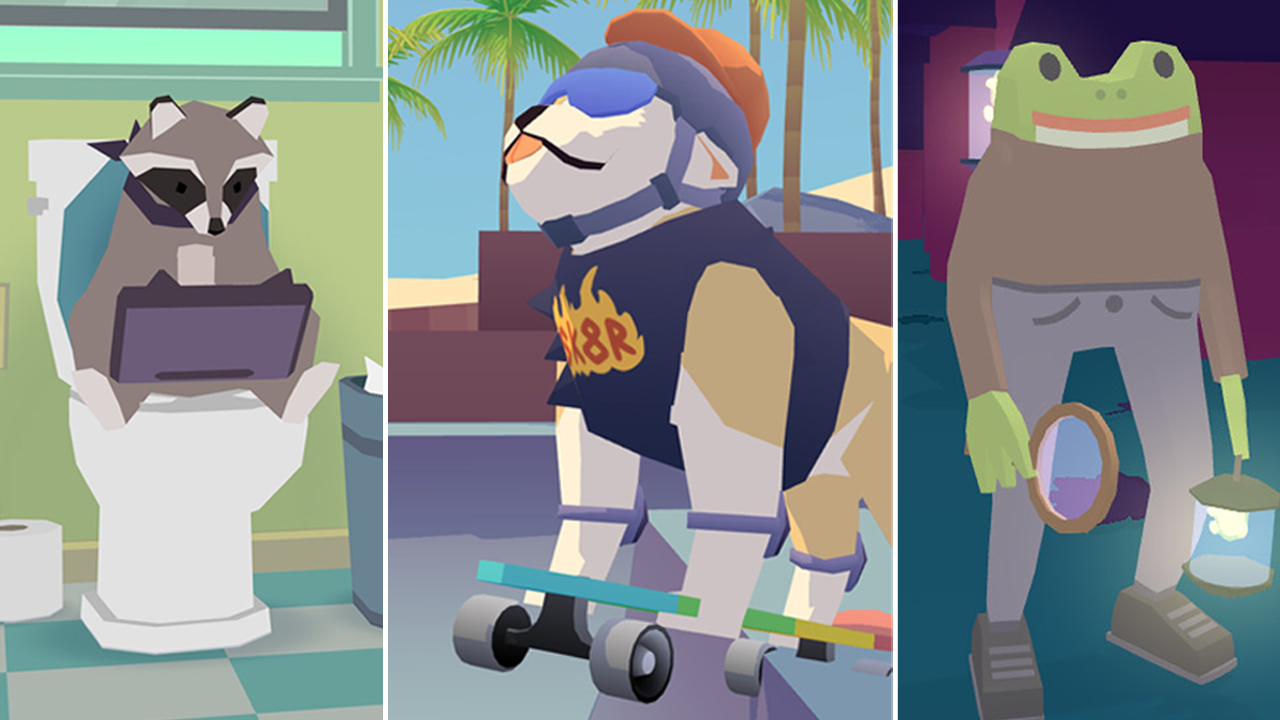Among the vast line up of AAA masterpieces, indie hack-and-slash dungeon crawlers, and the endless sea of farming simulators of all sizes, there exists a category of games which seems to ask “What do you actually need to have fun in a game?”. Games like Pupperazzi, Donut County, and Frog Detective seem to forgo the usual checklist that other titles use as a standard, and instead carve a path all their own. There’s no addictive gameplay loops, no dungeon diving, no stat lists or complex survival systems, no photo-realistic visuals, and no grand dramatic story pushing the player toward the next big reveal. Instead, these games utilize humor, low poly visuals, and cute animals to deliver an experience that is uniquely wonderful.
Pupperazzi is a new photography sandbox game from developer Sundae Month and publisher Kitfox Games, which puts you in the shoes of a sentient camera and tasks you with snapping pictures of goofy dogs. It also tasks you with petting the dogs, playing with the dogs, dressing up the dogs, dancing with the dogs, and on rare occasions, lightly scaring the dogs. The dogs are clearly the stars of the show, but the animation is what takes Pupperazzi to another level.

The true charm comes from the game’s dedication to absurdity. As if being a living DSLR wasn’t enough, you are given tasks in the game by your sentient camera father, who sports a large dad-stache. Many of your requests involve snapping pictures of dogs engaged in wacky activities like skateboarding, surfing, and riding mopeds. You encounter humans in the game as well, but they’re all faceless “robots” who the dogs say are in charge of handling all the boring stuff like “math”. Tying all of this absurdity together is the animation of the dogs themselves. None of the low poly dogs have any joints (aside from their tails, which they lovingly wag when you pet them). Regardless of what activity any dog is engaged in, they remain stiff as a board, hopping and rolling around the world. While some might criticize the developers for skimping on animation costs or cutting corners, the simplistic movement style feels like a design choice, one which defines the whole tone of the game.
Games are an entertainment artform, and much like other forms of art as entertainment, they’re subject to the demands of the audiences they seek to entertain. Whether sitting down to watch a movie or browsing sketch comedy on YouTube, audiences subconsciously project their expectations of what the medium can offer based on the highest achievable levels in that medium. Because big-budget Marvel movies exist, audience members now expect the same high level of quality in all cinema, even if they don’t realize it. Similarly, when you watch a sketch on YouTube, your brain is conditioned by SNL, Aunty Donna, and BriTANick – sketch groups with great lighting design, sound quality, and shooting locations – that you may find it harder to watch videos with lower production quality, even if the content and the comedy is good. The same is true within the games industry. Huge AAA titles like The Last of Us, Halo, Horizon Zero Dawn, and Skyrim set players’ expectations strikingly high, making it difficult for indie devs who want to explore similar spaces, but don’t have the time or budget to craft the same level of realism.

If you’ve ever been to an improv comedy show or seen a play in a blackbox theater, you know the joy of watching actors create whole worlds out of thin air. Our CGI Marvel expectations would deem that these productions fail the test and should be left behind, yet audiences continue to be enthralled in spaces with minimal set design, minor lighting queues, and little to no props or costuming. Spaces where artists reject high standards of production in favor of minimalism and simplicity can get a pass from our subconscious drive for perfection. In the world of humor especially, a commitment to absurdity allows us to silence our critical minds. Watching somebody struggle with an ill-fitted wig or costume, make due with a mop for a sword, or clash with inelegant set designs would seem out of place in a large-scale big-budget production. But the commitment to this absurdity becomes a nod to the audience. “We also know this is ridiculous. Let’s all have fun with it together.”
Grace Bruxner and Thomas Bowker’s Frog Detective series casts you in a role you may guess from the title: an amphibious mystery solver. Each game, The Haunted Island, a Frog Detective Game and Frog Detective 2: The Case of the Invisible Wizard, provides a short, low-stakes mystery for you to unravel, supported by a cast of kooky animals. You’ll help a sloth find peace on his island and help a town find out who destroyed the decorations for their upcoming party. Much like the stiff dogs of Pupperazzi, Frog Detective’s animal characters are only as detailed as they need to be, once again providing a silly (but solid) foundation for the game’s sense of humor to build on. These games won’t be battling Hideo Kojima for ‘Most Complex Plotline’, they’re simply setting out to make you feel joy. Whether it’s looking at little bug faces through your magnifying glass, witty dialogue, 4th wall breaks, or dance battles, Frog Detective will likely have you laughing on more than one occasion. All the while it feels like Grace and Thomas are right there playing with you, saying, “We know that bug looks silly. Isn’t it wonderful?”

Spend any amount of time browsing Steam and you’ll come across thousands of games that aim for some level of realism in their world and their characters, but ultimately fall devastatingly short. Game coding is a daunting process, and even using pre-designed assets may not help developers attain satisfying realism, especially for human characters. Both Pupperazzi and Frog Detective utilize animal protagonists, which helps avoid the eerie danger zone of the uncanny valley. However, the real saving grace is the low poly models. By committing to a low poly world, developers like Grace Bruxner and Sundae Month avoid falling into the dangerous middle ground of “almost real.” The choice to use simpler character models maintains the charm that makes each game such a treat to experience.
Donut County from Ben Esposito was published by the indie powerhouse Annapurna Interactive, theoretically granting access to greater development resources, yet still utilized stiff character models, low poly worlds, and a commitment to joy. The game follows a mischievous raccoon named BK as he slowly swallows up all of his friends, and the town they all live in, with a strange ever-growing hole. BK ultimately goes toe-to-toe with the Raccoon King in a quest to revert his misguided swallowing, which is certainly a more daring adventure than what you find in Frog Detective or Pupperazzi, but they all share a certain level of absurdity and humor. Add in the fact that all of these games utilize animal protagonists earnestly pursuing their own goals – in the case of Pupperazzi, the protagonist is the collection of dogs and their goal is to be photographed more – and it all comes together for a whimsical experience that is hard to find in other titles.

Through all the layers of farce and humor, each adventure manages to tackle deeper themes, proving that these games can and should still be taken seriously. Frog Detective explores mental health and support, Donut County examines personal responsibility, and at its core Pupperazzi is an exploration of the joy found in companionship. These developers don’t let themselves get bogged down by the expectations of how to explore those themes, and instead opt for a simpler approach. At the end of the day, a video game is not defined by flashy graphics and complex plotlines. A game is just meant to be fun. And sometimes fun is sitting on a beach petting 20 polygonal dogs.






Case for joy: made. Lemme pet them pups!